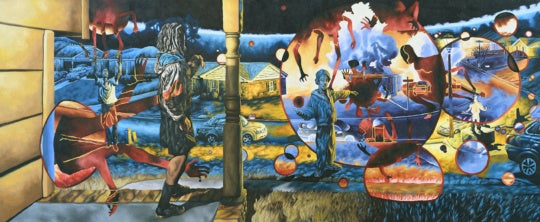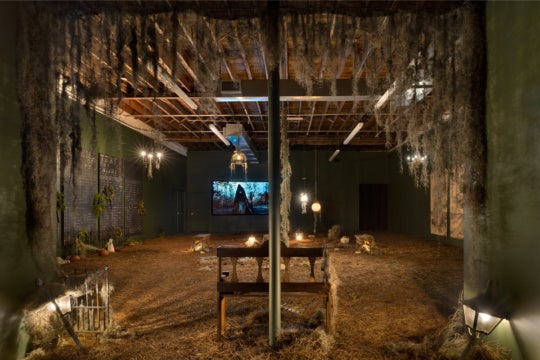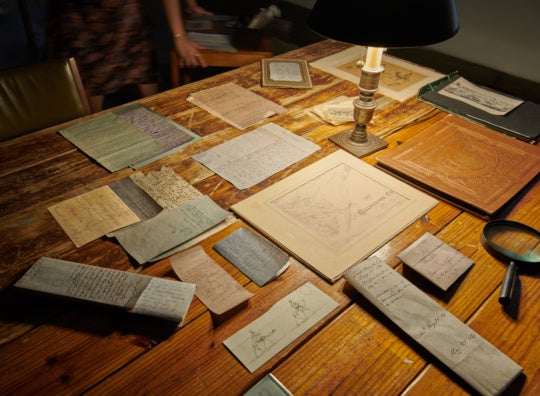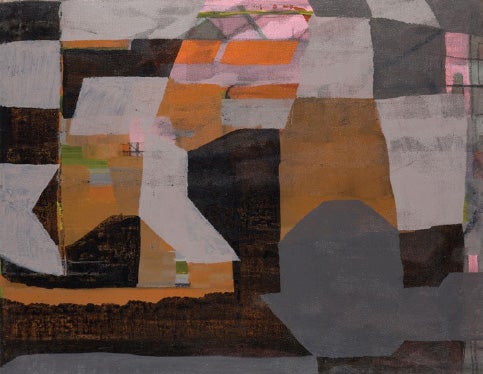
21¾ by 28¼ inches.
In “new way to forget,” Clayton Colvin’s third solo exhibition at beta pictoris gallery, we see the artist exploring what can only be termed “soft abstraction.” Intelligently and unapologetically walking a ground that meshes figuration and abstraction into a practice— more grounded in the latter and structured by the former—Colvin is at a stage in his career where he is far more interested in teasing out the edges of an idea than he is in categorizing a concept.
With this show, Colvin has almost, though not entirely, abandoned his earlier, more complex hard-edged radical geometries in favor of a saturated and fluid field. Glanton and The Land, in particular, are marked by patches of color that look as if they have literally pooled and spread on the linen surfaces of the canvases. Perhaps a reference to the characters in Cormac McCarthy’s novel Blood Meridian, the red edges of Glanton look as if blood has dripped from above. As with many of the other works in the exhibition, Glanton makes a literary reference that may or may not resonate with the viewer, something Colvin is unapologetic for. The experience of his works does not hinge on a higher understanding of his references, although this knowledge adds an additional layer—a respite filled with both humor and darkness —that separates the visual from both the cerebral and the emotional.

over panel, 28¼ by 21¾ inches.
In an era of arch referencing and post-historicist sarcasm, Colvin’s truest predecessor is, in fact, Paul Klee. Colvin’s works attempt to further the strange combination of the spiritual and the aesthetic that defined Klee’s abstraction. Like a string in a maze is Colvin’s closest relative, but it in no way feels derivative. Perhaps it is in the way in which, at a distance, Like a string seems to resolve into something almost figurative, perhaps alluding to Theseus in the Minotaur’s maze.
The Nursery, described in the press release as a mixing of Colvin’s pixelated squares with more natural imagery, instead seems to dissolve into domestic architecture. Perhaps this is one of the many nods to the contemporary that emerges throughout the show. Between those nods and the hat tips to art history, Colvin essentially takes viewers on a journey between past and present and between high and popular culture, themes usually absent from abstraction.
Of particular interest is The Ledger. Had Jacques Derrida painted the work, he might have titled it “Of Bracketology.” Here, one of the clear signifiers in the exhibition emerges, a “bracket,” the diagram that defines who plays whom in a sporting event. Blue and black diamonds scattered across the canvas suggest players on a field of various earth-toned brushstrokes. The composition seems enclosed in a cube, which either advances or recedes the picture plane, making the work both pictorial and abstract.
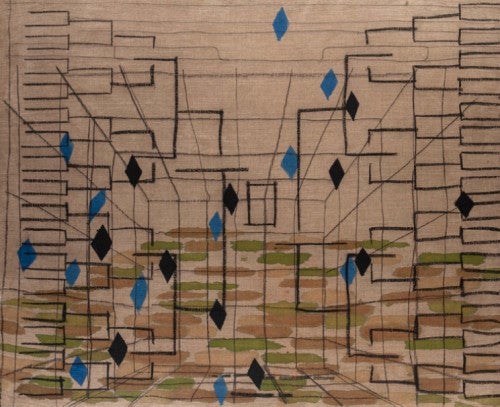
and india ink on linen over panel, 46 by 56 inches.
At his most reserved, Colvin simply makes marks on a linen support, as he does for the foundations of Leap Across the Centuries and The Land. The single hash mark is also the ground for The Reader. In each of these works, Colvin essentially flattens the picture plane, bringing everything visually to the surface. In The Pillow, or Frontiersman, on the other hand, he creates the illusion of depth through the flatness of a single color laid on the image’s surface and the complexity of the composition seemingly below.
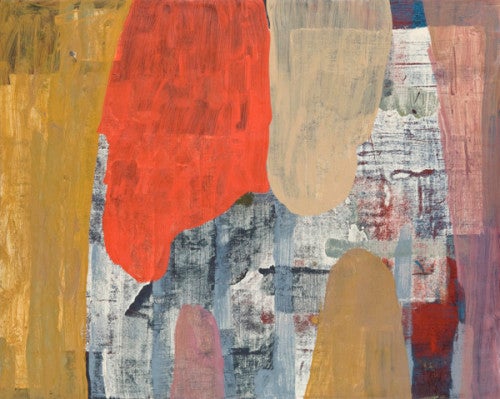
and india ink on Arches hot press watercolor paper over panel,
16 by 20 inches.
Finally, there is Popular Tactics, the only work on paper in the exhibition. Simply because of its materials, it feels different from the other pieces. It is rich in depth, layered, and complex. At first glance, it is difficult to determine why it might seem “other,” but it is the result of the paper on wood, as well as the opportunities this afforded Colvin in terms of exploring and pushing the limits of the materials.
“New way to forget” is a quiet exhibition. There are no loud colors or bold statements. Instead, it asserts itself through references to multiple histories, including those of art and literature, and of the present, whether shared or individual. It represents a strong commitment to the practice of painting as much as to its meaning. If you would rather not remember how banal much contemporary culture has become, these complex works can certainly provide a new way to forget.
“Clayton Colvin: new way to forget” is on view through March 27 at beta pictoris gallery in Birmingham.
Brett Levine is a writer and curator based in Birmingham.

